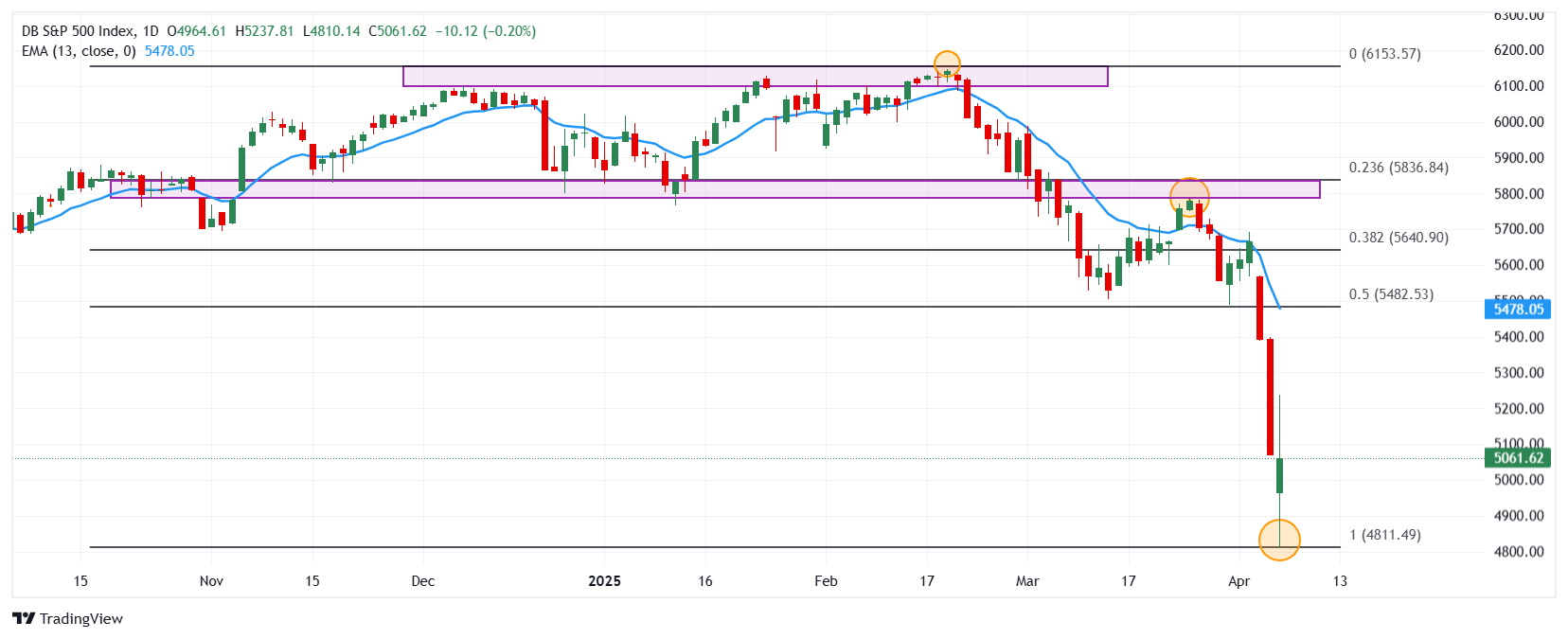- The S&P 500 stock index loses 0.20% today, operating when writing in 5,061.
- Donald Trump announced an additional 50% tariff to products from China if the Asian country does not withdraw the 34% rate to American goods, effective as of April 9.
- The actions of Tractor Supply Company (TSCO) fall by 5.82% daily, reaching minimums not seen since April 16, 2024.
- The look of investors will be set on the Minutes of the FED and the United States consumer price index.
The S&P 500 reacted upwards from minimum of January 19, 2024 in 4.810, where it found aggressive buyers who promoted the index to a daily maximum in 5,237. At the moment, the S&P 500 is quoted in 5,061, losing 0.20% on Monday.
The S&P 500 reaches minimum of fifteen months after Trump’s tariff threats
The president of the United States, Donald Trump, announced through his social social network, a possible 50% additional tariff to China. This scenario would be presented in the event that the Asian country does not withdraw the rates of 34% to American goods, no later than April 9.
After this news, the S&P 500 reached minimal not seen since January 19, 2024 in 4.810, where the actions of Tractor Supply Company (TSCO) led the losses in the share index, falling 5.82%, visiting levels not seen since April 16, 2024 in 4,882.
The focus of investors will be on the Minutes of the Federal Reserve to be published on Wednesday, April 9, as well as in the United States Consumer Price Index, scheduled for Friday, April 11.
Levels to be considered in the S&P 500
The S&P 500 established a short -term resistance given by the maximum of March 25 in 5,784. The next key resistance is observed in 6,145, maximum of February 19. Downwards, the important support is in 4,662, pivot point of January 5, 2024.
S&P 500 DAILY GRAPH

S&P 500 FAQS
The S&P 500 is a very often stock index that measures the yield of 500 public companies and is considered a wide measure of the US stock market. The influence of each company on the calculation of the index is weighted based on stock capitalization. This is calculated by multiplying the number of bought shares of the company for the price of the action. The S&P 500 index has achieved impressive yields: 1.00 $ invested in 1970 would have produced a yield of almost $ 192.00 in 2022. The average annual profitability since its creation in 1957 has been 11.9%.
Companies are selected by committee, unlike other indices included in established standards. Even so, they must fulfill certain eligibility criteria, the most important of which is stock market, which must be equal to or greater than 12.7 billion dollars. Other criteria are liquidity, domicile, stock capitalization, sector, financial viability, quotation time and representation of the sectors of the United States economy. The nine largest companies in the index represent 27.8% of the stock market capitalization.
There are several ways to operate with the S&P 500. Most of the Stred Betting retail runners and platforms allow operators to use contracts per difference (CFD) to make bets on the price direction. In addition, indexed funds, investment funds and quoted funds (ETF) that follow the price of the S&P 500 can be purchased. The most ETF liquid is the ETF of the London Stock Exchange. The most ETF liquid is the State Street Corporation Spy. The Chicago Mercantile Exchange (CME) offers futures contracts on the index and the Chicago Board of Options (CMOE) offers options, as well as ETF, ETF Inverse and ETF leverage.
There are many factors that promote S&P 500, but mainly it is the aggregate performance of the companies that compose it, revealed in their reports of quarterly and annual results. American and world macroeconomic data also contribute, since they influence investors’ confidence, which is positive drives profits. The level of interest rates, set by the Federal Reserve (FED), also influences the S&P 500, since it affects the cost of credit, which is largely depending on many companies. Therefore, inflation can be a determining factor, as well as other parameters that influence the decisions of the Federal Reserve.
Source: Fx Street
I am Joshua Winder, a senior-level journalist and editor at World Stock Market. I specialize in covering news related to the stock market and economic trends. With more than 8 years of experience in this field, I have become an expert in financial reporting.







